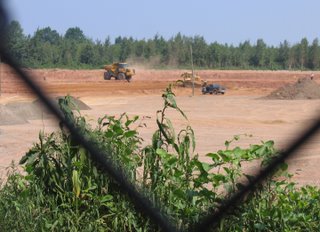Thank you sir, may I have another?
 It has happened yet again - *sigh*. Wild potato vine (Ipomoea pandurata) has once again been cut to the ground.
It has happened yet again - *sigh*. Wild potato vine (Ipomoea pandurata) has once again been cut to the ground.
Here's the problem, this plant, an herbaceous vine, (related to that chartreuse green windowbox favorite) existed in an area that was made into a recreational park. Despite all thoughts to the contrary, the plant came back a few years after it had been hacked to the ground to create said park. However, the plant doesn't know that things have changed. This (unnamed) park is now manicured and all things not trees get weed whacked. (This seems to be true of all NYC Parks - unskilled labor + pruning equipment = death to all plants not 50 ft tall. I'm not exaggerating). Imagine, a vine growing up a fence in a highly managed park. How unseemly! thwack
Why care? Well, wild potato vine is a New York State rare plant. And this site is its only occurrence in New York City. I am meeting with the park manager next week to discuss long term solutions to protect this plant. Which I've done every year around this time. My suggestion for 2007 is going to be a security guard.









